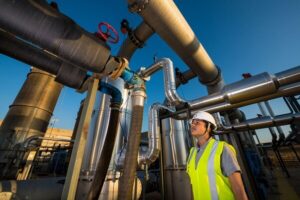
Biomethane is the energy of the future. Produced from the decomposition of organic waste, this fuel promises to be a renewable, clean, and easily accessible solution, as it comes from a recurring and abundant raw material. But, after all, how is biomethane produced? Discover the entire process.
What is biomethane
Biomethane is a renewable fuel obtained from the purification of biogas — a gas similar to natural gas, produced during the decomposition of organic waste in oxygen-free environments, a process known as anaerobic digestion. This waste can come from various sources.
The transformation of biogas into biomethane occurs through a process called upgrading, in which impurities are removed and methane is separated from carbon dioxide. The result is a gas with a high concentration of methane, with characteristics similar to natural gas.
Therefore, biomethane is a sustainable and versatile alternative: it can directly replace compressed natural gas (CNG) in transportation, as well as be used in industrial and residential applications.
How biomethane is made from organic waste
Orizon transforms organic waste into biomethane at its Ecoparks, facilities with integrated solutions and waste valorization technologies, where the received material is reused.
The production of biomethane starts with the disposal of organic waste and follows these steps:
Caption: Biomethane production steps. Image generated by AI
- Collection and preparation of raw material
Urban solid waste is collected and sent to the Ecoparks, where it serves as a substrate to generate biogas.
- Anaerobic digestion
The organic material is sent to the sanitary landfill, where it is compacted and layered. After this preparation, anaerobic digestion begins — a biological process in which microorganisms break down organic matter in the absence of oxygen.
This step can last from 15 to 40 days, depending on the type of substrate, temperature, and technology used. It generates:
- Raw biogas, mainly composed of methane (CH₄) and carbon dioxide (CO₂);
- Digestate, solid and/or liquid residue that can be used as a source of organic fertilizer.
- Impurity removal (pre-purification)
Before purification, the biogas undergoes treatments to remove elements that may damage equipment or reduce biomethane quality:
- H₂S (hydrogen sulfide) removal: using chemical filters, scrubbers, or biofilters;
- Dehumidification: moisture removal through condensation (cooling) or dryers;
- Solid particle filtration: using filters to remove suspended impurities.
- Upgrading (biogas purification)
In this step, the biogas is treated to remove carbon dioxide and obtain a gas with a high concentration of methane (above 90%, up to 98%). The main methods are:
- Physical absorption: using water or organic solvents to capture CO₂;
- Chemical absorption: using chemical solutions that react with CO₂;
- Pressure swing adsorption (PSA): gas separation based on adsorption properties under different pressures;
- Selective membranes: membrane filtration systems that separate methane from CO₂;
- Cryogenic: cooling the biogas to liquefy gases and allow separation.
- Compression and/or storage
The purified biomethane can be:
- Compressed (CBG – Compressed Biomethane Gas): for use as vehicle fuel (equivalent to CNG);
- Liquefied (LBG – Liquefied Biomethane Gas): for long-distance transport or higher energy density storage;
- Injected into the natural gas grid: if it meets technical standards.
- Distribution and end use
Biomethane is a direct substitute for fossil fuels and, being equivalent to natural gas, can be used in various applications:
- Transportation: as a sustainable fuel for light and heavy vehicles;
- Industries: a substitute in thermal processes;
- Fertilizer production: as a nitrogen-rich raw material when associated with digestate.
Just in the biomethane production at Orizon’s Ecoparks, 1,300,000 m³ of biogas per day can be captured, representing a major environmental benefit by preventing the release of a significant amount of greenhouse gases.
- Want to learn more about the benefits of biomethane and why it is the energy of the future? Click here.



